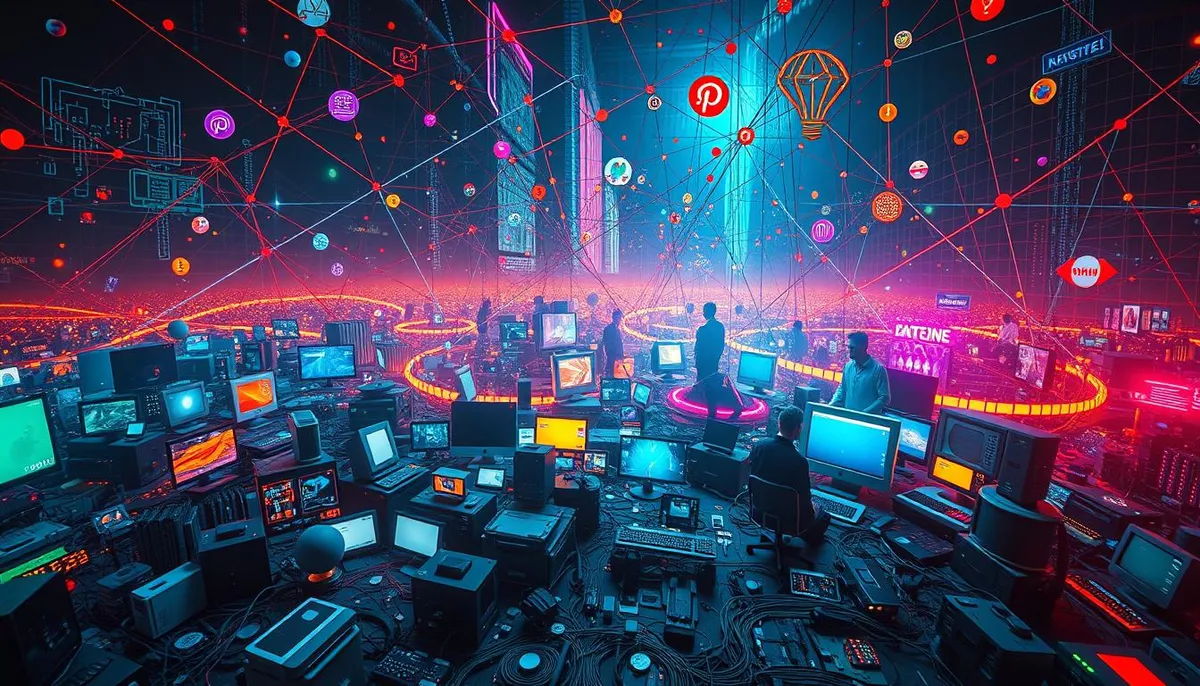The understanding of current trends in digital culture is essential for navigating today's online landscape.
Online phenomena shape the way we communicate, interact, and consume information.

To stay updated, it is crucial to understand the latest trends and their impact on our daily lives.
These trends reflect changes in our online behaviors and preferences.
Definition and evolution of internet culture
Digital culture has become an essential element of our society, transforming the way we consume and share information. It encompasses a wide range of phenomena, from social networks to online communities.
What is internet culture?
Internet culture refers to the practices, beliefs, and forms of expression that emerge and evolve on the Internet. It is characterized by its decentralized nature and open access to content creation and sharing.
- Memes that spread rapidly
- Social media platforms that shape our interactions
- Online communities that create their own norms and languages
From cyberculture to digital culture
The transition from cyberculture to digital culture reflects the evolution of technologies and usages. Cyberculture initially referred to alternative and underground cultures on the Internet.
With the expansion of the Internet and its normalization, digital culture has become mainstream, increasingly integrating aspects of daily life.
The history of internet culture
Internet culture, a complex phenomenon, has its roots in technological and social developments. To understand its cultural evolution, it is essential to trace its history.
The technological origins
The Internet began as a military project before becoming a global network. The first information technologies laid the foundations for internet culture. ARPANET, developed in the 1960s, is considered one of the first packet-switching networks.
Global expansion and democratization
With the advent of the World Wide Web in the 1990s, the Internet experienced rapid expansion. This period saw the democratization of Internet access, allowing a broader audience to participate in online culture.
| Period | Event | Impact |
|---|---|---|
| 1960s | Development of ARPANET | First packet-switching network |
| 1990s | Appearance of the World Wide Web | Rapid expansion of the Internet |
| 2000s | Rise of social networks | Transformation of online communication |
The linguistic and cultural evolution
The Internet has also influenced language and culture. The emergence of new terms and acronyms, such as “LOL” or “meme,” reflects this evolution. Moreover, online platforms have enabled the creation and dissemination of diverse cultural content.

Current trends in internet culture
Internet culture is in constant flux, impacting various aspects of our lives. This ongoing evolution is shaped by several key factors that influence how we interact, create, and consume content online.
Social networks and their influence
Social networks have become essential platforms for the dissemination and consumption of content. They influence our preferences, opinions, and even our social relationships. Facebook, Instagram, and Twitter are among the most used, each having its own ecosystem and type of content.
Here are some statistics on social media usage:
| Social Network | Number of users (in millions) | Main Use |
|---|---|---|
| 2800 | Social networking | |
| 1200 | Photo and video sharing | |
| 440 | Real-time discussion |
Memes and content virality
Memes are a form of humorous or satirical expression that spreads rapidly online. They often reflect current trends and concerns. The virality of content is a key phenomenon in internet culture, allowing ideas or cultural elements to spread widely in a short time.
The emergence of online communities
Online communities form around common interests, creating spaces for discussion and sharing. These communities can have a significant impact on online culture and beyond, influencing behaviors and trends.
Internet culture continues to evolve, shaped by technological advancements and changes in social behaviors. Understanding these trends is essential for navigating this constantly changing landscape.
The revolution of media practices
The digital age has led to a radical transformation in how we consume media. This revolution has been marked by significant changes in our consumption habits, influenced by the evolution of digital technologies and the expansion of the Internet.

The decline of traditional media
Traditional media, such as print journalism and terrestrial television, are experiencing a notable decline. The rise of digital platforms has diverted consumer attention, leading to a decrease in the consumption of these traditional media.
Print journalism has been particularly affected, with a significant drop in newspaper sales and subscriptions. Publishers now must turn to digital models to survive.
The rise of the “screen culture”
The “screen culture” has become ubiquitous, with a majority of the population spending a significant part of their time in front of screens. This trend is fueled by the proliferation of smartphones, tablets, and laptops.
This new culture has profound implications for how we interact with information and media. Content is now designed to be consumed on screens, influencing its format and style.
On-demand content consumption
On-demand content consumption has become the norm, thanks to streaming platforms and video-on-demand services. Consumers can now access a vast library of content at any time, without being tied to programming schedules.
This flexibility has revolutionized the way we consume media, allowing us to choose what to watch, when, and where we want.
The impact of internet culture on cultural practices
Internet culture has profoundly changed our daily cultural practices. From how we consume music and films to how we read, the Internet has brought significant changes.
The transformation of reading
Reading has undergone a notable transformation with the advent of the Internet. Digital books and online reading platforms have altered our reading habits. Readers can now access a vast library of texts at any time.
Blogs and social networks have also allowed readers to share their opinions and discover new authors.
Music in the streaming era
Streaming has revolutionized the way we consume music. Platforms like Spotify and Apple Music offer instant access to millions of songs.
This has changed not only how we listen to music but also how artists produce and release their music.
The evolution of cinematic preferences
Streaming platforms like Netflix and Amazon Prime have altered our cinematic preferences. They offer a wide variety of content, including original productions that may not have otherwise come to fruition.
This has also changed how we watch movies and TV series, with the possibility of binge-watching and discovering new genres.
The social and generational dimension
Understanding internet culture requires an analysis of its social and generational dimensions, including the comparative themes bts. This approach allows for a better grasp of current trends and their impact on society.
Digital natives and their relationship to culture
Digital natives, born after the 90s, have grown up with the Internet and digital technologies. Their relationship to culture is profoundly influenced by immediate access to information and the ability to share their experiences online. This generation perceives culture differently, favoring interactive content and social media platforms. Furthermore, the concept of stopping culture and training plays a crucial role in how they engage with digital content and participate in online communities.
The digital divides
Despite the democratization of the Internet, digital divides persist. They manifest as disparities in access to technologies, digital skills, and participation in online culture. These divides can reinforce social and generational inequalities.
Internet culture as a social marker
Internet culture has become an important social marker. Mastery of online codes and trends can influence social integration and recognition within certain communities. This reflects how individuals position themselves and are perceived in the digital space.
In summary, the social and generational dimension of internet culture is complex and multifaceted. It reveals both the opportunities offered by digital technologies and the challenges related to their appropriation.
Cultural creation and participation in the digital age
The digital age has revolutionized the way we create and participate in culture. With the advent of the Internet and social networks, the barriers to entry for content creation and dissemination have been significantly reduced. This has allowed for a flourishing of independent art, enabling artists to express themselves and share their work with a global audience.
The emergence of amateur creators
The Internet has enabled many people to become content creators, even without prior experience or training. Platforms like YouTube, TikTok, and SoundCloud have given individuals the opportunity to share their creations with a global audience.
These amateur creators bring diversity and freshness to the content available online, enriching the digital cultural landscape.
Online collaboration and sharing
Online collaboration has become a key feature of cultural creation in the digital age. Collaborative projects, such as wikis and online music productions, illustrate how individuals can work together to create something new and innovative.
Online sharing also facilitates the dissemination of cultural creations, allowing artists and creators to reach a wider and more diverse audience.
New forms of cultural expression
The digital age has given rise to new forms of cultural expression, such as digital installations, virtual reality, and video games. These new forms push the boundaries of creativity and offer new experiences to culture consumers.
They also open new perspectives for creators, allowing them to experiment and innovate in their works.
Towards a digital humanism: future perspectives
As we move forward in the digital age, it is crucial to understand the implications of internet culture. Internet culture shapes our world significantly, influencing our social interactions, cultural practices, and the way we consume information.
The transition to a digital society involves not only technological advancements but also an evolution of values and behaviors. It is essential to consider social and generational aspects to understand how internet culture can be a vector for positive change.
The emergence of new forms of cultural expression and the active participation of individuals online are key elements of this evolution. Online communities and amateur creators play an increasingly important role in the creation and dissemination of content.
To move towards a digital humanism, it is necessary to promote an inclusive and responsible digital culture. This involves addressing digital divides and working to reduce inequalities in access to information and technologies.
In conclusion, internet culture is a complex phenomenon that requires a nuanced understanding of its implications. As we advance towards a digital future, we must strive to create an online environment that fosters exchange, creativity, and inclusion.
RelatedRelated articles


